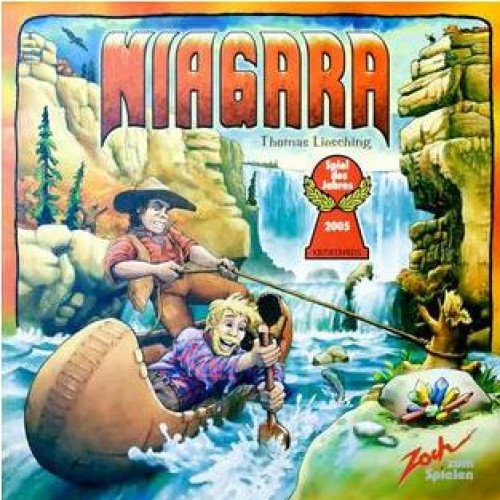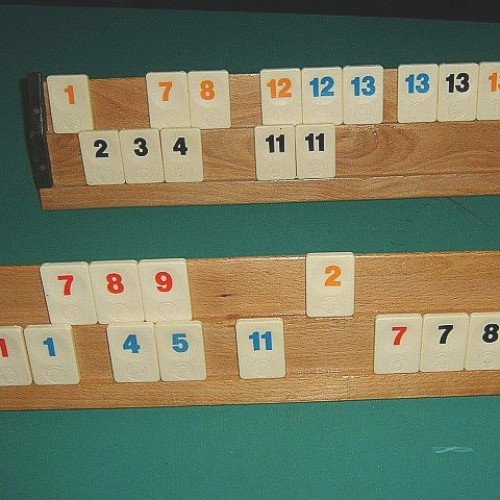"NIAGARA" vs "OKEY"

NIAGARA
Niagara is a German-style board game designed by Thomas Liesching and published in 2004 by Zoch Verlag and Rio Grande Games. The game is played on a hinged board designed to sit atop the game box and represent Niagara Falls as a flap hanging over the box edge. The river is represented using clear plastic discs in a grooved surface, allowing board spaces to move downstream toward the waterfall. Players collect gems along a river. Players move canoes to transport the gems, and can steal gems from other players' canoes. They may also influence the speed with which the board spaces move downstream. The first player to acquire four gems of one colour, or one of each of the five colours, or seven gems of any colour, is the winner. Although the game box states that gems closer to the waterfall are of higher value, the game treats all colours equally.
Statistics for this Xoptio

OKEY
Okey (Turkish pronunciation: ) is a tile-based game, very popular in Turkey. It is almost always played by four players, although, in principle, it can be played by two or three players. It is very similar to the game Rummikub, as it is played with the same set of boards and tiles, but under a different set of rules. The game was derived from the original Rummikub after cultural contacts of Gastarbeiter in Germany. In Turkey and among Turkish communities abroad, it is very popular at cafés. The first dealer is chosen at random. After the hands have been played and scored, the turn to deal passes to the right. The 106 tiles are placed face down on the table and thoroughly mixed. Then the players set them up into 21 stacks of five tiles, the tiles in each pile being face down. One tile is left over - this is temporarily kept by the dealer. There is no specific rule about how many stacks should be in front of each player. It is convenient to have at least six in front of the dealer, but this makes no real difference to the game. The dealer now throws the die twice. The result of the first throw selects one of the tile stacks in front of the dealer, counting from left to right. The dealer places the single remaining tile on top of this selected stack. If the number thrown is greater than the number of stacks in front of the dealer, then the count will continue using the stacks in front of the player to dealer's right, and one of these will be selected. The selected stack now has six tiles. The second throw of the die selects one of the tiles in the selected stack, counting upwards from the bottom of the stack. The selected tile is extracted from the stack and placed face up on top of it. If the selected tile is a false joker, it is returned to the selected stack and the second throw of the die is repeated until a numbered tile is selected. This face up tile determines the "joker" (okey) for the game - a wild tile that can be used to represent other tiles to complete a combination. The joker is the tile of the same colour and one number greater than the face up tile. For example if the face up tile is the green 10, the green 11s are jokers. The false jokers are not wild - they are used only to represent the tiles that have become jokers. So for example when the green 11s are jokers, the false jokers are played as green 11s (and cannot represent any other tile). If the face up tile is a 13, the 1s of the same colour are jokers. Now the stacks of tiles are distributed to the players. The player to dealer's right will receive 15 tiles and the others 14 each. The player to the right of the dealer takes the next stack after (to the right of) the selected stack with the face up tile on top of it, then the player opposite the dealer takes the following stack, and so on anticlockwise around the table, until each player has two stacks (10 tiles). Now the player to the dealer's right receives the whole of the next stack, but the player sitting opposite the dealer is given only the top 4 tiles of the following stack. The player to the dealer's left receives the last tile of this stack and 3 tiles from the top of the next stack, and finally the dealer takes the last 2 tiles from this stack and 2 from the next stack. In the above diagram the dealer threw a 5, placed the spare tile on top of the 5th stack from her left. She then threw a 2, and took the second tile from the bottom of the selected stack and placed it on top. It is a red 4, so red 5s will be jokers for this deal. Now player 2 must take stack 'a', player 3 stack 'b', player 4 'c', player 1 'd', player 2 'e', player 3 'f', player 4 'g', player 1 'h' and player 2 'i'. Next player 3 takes the top 4 tiles of stack 'j', player 4 the last tile of 'j' and three from 'k', and player 1 two from 'k' and two from 'l'. All the players should arrange their tiles so that they can see their faces but the other players cannot. Wooden racks are often used for this. The remaining tiles are left for the players to draw from during the game. They are moved to the middle of the table, without looking at them or disturbing their order.